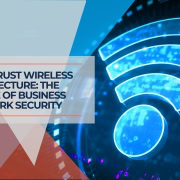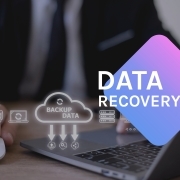Cloud Data Security 2024: Your Essential Guide
Last Updated on April 12, 2024
The cloud revolutionized the way we store and access data. For businesses, it means ditching expensive servers and embracing the flexibility to scale up or down as needed. Individuals enjoy the convenience of accessing their files from any internet-connected device. Yet, as the cloud grows, so do the digital threats targeting the vast data stored remotely. This article is your essential guide to understanding and protecting your business's valuable information in the cloud.
Table of Contents
Crucial Cloud Data Security Threats
Let's start by understanding the dangers lurking in the cloud:
- Data Breaches: Hackers constantly evolve their techniques to break into cloud systems. A successful breach can lead to the theft of sensitive information like customer data, financial records, or intellectual property.
- Malware and Ransomware: These malicious programs can infect cloud environments, stealing data or encrypting it for ransom. Cloud-specific malware strains are particularly dangerous.
- Misconfigurations: Incorrect security settings are surprisingly common. These oversights create holes hackers can easily exploit to access your data.
- Insider Threats: Employees, contractors, or ex-employees with authorized access pose a risk. They might misuse or leak data, whether intentionally or accidentally.
- Vendor Lock-In: Some cloud providers make it difficult to switch platforms. You could face hefty fees, data migration issues, or a provider who doesn't meet your security needs.
Must-Have Cloud Data Security Measures
Protecting your business in the cloud isn't a one-and-done task. Think of it as building a fortress with layers of defenses:
- Strong Encryption: Encryption scrambles your data, making it unreadable without the correct key. Choose providers that offer robust encryption both when your data is stored (“at rest”) and when it's being transferred (“in transit”).
- Multi-Factor Authentication (MFA): MFA goes beyond the traditional password. It adds an extra layer of security, often requiring a code sent to your phone or the use of a security key. This makes it much harder for hackers to break in, even if they steal a password.
- Zero-Trust Architecture: This approach assumes no user or device should be trusted automatically. It involves strict controls, isolating systems, and always verifying before granting access. If a breach occurs, it's harder for attackers to move around your cloud environment.
- Identity and Access Management (IAM): It is crucial to control who can access what and how much access they have. IAM solutions help you give employees only the permissions they need (the principle of least privilege).
- Regular Backups and Disaster Recovery: Backups are your safety net. Reputable cloud providers offer redundancy, but it's wise to have your own independent backups. It's vital to have a tested disaster recovery plan to restore data quickly in case of an outage or attack.
Selecting a Secure Cloud Service Provider
Choosing a cloud provider isn't just about price and features – security should be a top priority. Here's what to look for:
- Security Certifications: Opt for providers who hold recognized certifications like ISO 27001 or SOC 2. These certifications demonstrate that the provider has undergone independent audits and has robust security practices.
- Transparent Security Practices: Don't hesitate to ask potential providers about their security measures. They should be able to provide clear documentation and reports from security audits and answer your questions in a way that inspires confidence.
- Data Location and Regulations: Ensure compliance with regulations like GDPR (Europe) or HIPAA (healthcare data in the US) if they apply to your business. You'll need to confirm where your data will be physically stored and how it will be handled.
- Service Level Agreements (SLAs): Review the provider's promises about uptime and how quickly they'll restore data after an incident. This gives you an idea of their reliability and how your business might be affected during an outage.
- Customer Support and Incident Response: Find out how the provider communicates with clients in case of a breach or security issue. Do they have clear procedures and dedicated teams to handle these situations?

The Hidden Costs of Cloud Data Breaches
Many businesses evaluate cloud providers based on storage space and features. However, it's vital to understand the potential financial impact of a security breach. Consider these costs beyond just the immediate data loss:
- Fines and Regulatory Penalties: Violating data protection regulations like GDPR or HIPAA can result in huge fines, especially for repeated or blatant negligence.
- Reputational Damage: News of a data breach erodes customer trust. Restoring your reputation might take years and be a significant expense, impacting future sales.
- Downtime and Recovery Expenses: While your cloud provider might be partially responsible for uptime, resolving a large-scale breach and restoring systems takes time and resources on your end as well.
- Legal Fees and Incident Response: In the aftermath of a breach, specialized cybersecurity firms and legal counsel are often needed, and these costs add up quickly.
It's tempting to think that once you choose a reputable cloud provider, your data security worries are over. The reality is that it's a shared responsibility:
- Cloud Provider's Role: They secure their physical infrastructure, the underlying software of their cloud platform, and some baseline security configurations.
- Your Role: This includes properly configuring security settings offered by the provider, using MFA, managing user access rights, encrypting sensitive data before uploading it, educating your staff, and having your backup plan.
Additional Tips for Cloud Data Security
Beyond the core security measures, here are some extra steps to take your cloud security to the next level:
- Security Awareness Training for Employees: Humans are often the weakest link in the security chain. Frequent training educates your staff about phishing scams, password safety, and reporting suspicious activity.
- Data Classification: Help employees understand the sensitivity of different types of data. Highly confidential information should be protected by additional layers of protection.
- Endpoint Security: Remember, the devices (laptops, smartphones, etc.) used to access your cloud data need robust security. This means antivirus software, firewalls, and regular software updates.
- Reviewing Permissions Regularly: When employees leave or change roles, it's vital to revoke old permissions promptly. Regular audits help catch outdated access rights that could be a security vulnerability.
Conclusion
Cloud data security is a constantly changing landscape. The best way to safeguard your business assets is to stay informed, make security central to your choices, and remain vigilant. Remember, cloud providers offer a significant part of the security solution, but you are also responsible for protecting your data by using their tools wisely and having your own security practices in place.
- Do you have experience with cloud security to share? Tell us about them in the comments!
- What other questions about keeping your data safe in the cloud? Let's discuss them.











Leave a Reply
Want to join the discussion?Feel free to contribute!